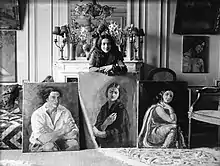
This is a list of paintings by Hungarian-born Indian artist Amrita Sher-Gil (1913 – 1941).[1] Over 60 of her paintings, of which most were portraits and self-portraits, were created between 1930 and 1932.[2] 19 were self-portraits painted in Europe between 1930 and 1934, and two, including one in a blue sari, were later completed in India.[3] Several of her paintings were of nudes; some of herself and others based on models of which all but one were female.[4]
In her early years, Sher-Gil worked at the École des Beaux-Arts, Paris, and won awards at the annual competitions for portrait and still life for three years in a row.[5] In the summer of 1932, Sher-Gil submitted six paintings to the "end of year concours", Paris, for which she received second mention in her capacity as foreigner.[6] The six included Violins, Nude Self-Portrait with Palette, and Young Girls.[6] In her words, "my work in those days was absolutely Western in conception and execution except for the fact that it was never entirely tame or conventional".[5]
Sher-Gil later wrote that "towards the end of 1933 I began to be haunted by an intense longing to return to India, feeling in some strange inexplicable way that there lay my destiny as a painter".[5] She subsequently painted Self-Portrait as a Tahitian in early 1934, while still in Paris.[7][lower-alpha 1] Upon arriving India in late 1934, produced The Little Girl in Blue.[8] In 1937, she painted what she called her plein-air series; created outdoors, away from a studio, and included her first paintings with animals.[9] These included The Story Teller.[9] 33 of Sher-Gil's works were displayed at her solo exhibition at Faletti's Hotel in Lahore, British India, held from 21 to 27 November 1937.[10] These included her first two compositions, The Story Teller and Siesta.[11] At Lahore, four paintings were sold in total; The Little Girl in Blue, The Story Teller, Pink Self-portrait, and the Vina Player.[12] "with the eternal significance of form and colour I interpret India and, principally, the life of the Indian poor on the plane that transcends the plane of mere sentimental interest".[5]
In 1938 five of her paintings were exhibited at the All India Fine Arts and Crafts Society's exhibition in Delhi, and included Elephants Bathing in a Green Pool (1938), Composition (1936), and View from Studio (1934), which won the prize.[13] In 1938, Sher-Gil married [Viktor Egan]] in Hungary, and there painted Two Girls among others. Returning to India in 1939, she moved to Saraya, Uttar Pradesh, and there her creations included Woman on Charpoy, Elephant Promenade, The Ancient Story Teller, Haldi Grinders.[14][15]
In 1940, six of her works were displayed at the Indian Academy of Fine Arts' Amritsar Exhibition (31 October - 10 November), to raise money for the War Fund.[15]
Under India's Antiquities and Art Treasures Act (1972), formed in accordance with the UNESCO 1970 Convention to regulate the internal and external dealing in antiquities in India, the Archaeological Survey of India in 1976 and 1979, named Sher-Gil's works as Indian treasure that if sold in India, cannot leave the country.[16] Of the at least 143 listed paintings created by Sher-Gil, most are held by her relatives, and 44 of the 45 paintings that belonged to Viktor Egan and some paintings that were with her father, were donated to the National Gallery of Modern Art, New Delhi.[17]
Paintings (1930)
| Painting | Year Name |
City, Gallery | Dimensions Technique |
Notes |
|---|---|---|---|---|
| 1930: Old Man with Beard |
Unknown[1] | Painted at La Baule, France[1] | ||
| 1930: Brown Girl |
Unknown[1] | |||
| 1930: Male Torso |
New Delhi, National Gallery of Modern Art | 62 × 94 cm Oil on canvas[1] |
||
| 1930: Sitting Nude |
New Delhi, National Gallery of Modern Art | 66 × 91.5 cm Oil on canvas[1] |
||
| 1930: Young Girl in Profile |
Unknown[1] | |||
| 1930: Portrait of Mother |
Private[18] | 49 × 65 cm Oil on canvas[18] |
||
| 1930: Portrait of My Sister |
Private[18] | 55.8 × 78.7 cm Oil on canvas[18] |
||
| 1930: Self-portrait with easel |
Private Collection[19] | 82.5× 90.5 cm Oil on canvas[19] |
Painted in Paris, it depicts a three-quarter Sher-Gil draped in red, in front of an easel.[7] | |
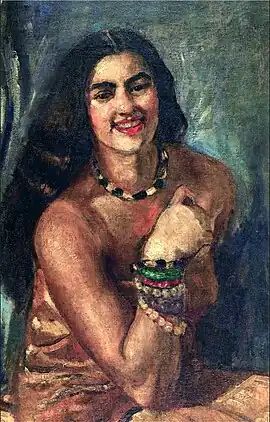 |
1930: Amrita Sher-Gil self portrait |
New Delhi, National Gallery of Modern Art | 47.4 × 70.2 cm Oil on canvas[18] |
Depicts Sher-Gil with a shoulderless dress and loose hair.[20][21] |
| 1930: Self-Portrait with Red Background |
Private[18] | 57 × 90 cm Oil on canvas[18] |
Painted in Paris.[22] | |
| 1930: Boris Taslitzky |
One of three portraits Sher-Gil completed of Boris Taslitzky. | |||
 |
1930: Portrait of a Young Man |
New Delhi, National Gallery of Modern Art | 61.5 × 74.3 cm Oil on canvas[23] |
One of three portraits Sher-Gil completed of Boris Taslitzky in Paris.[24] |
| 1930: Madam Taslitsky |
New Delhi, National Gallery of Modern Art | 54 × 79 cm Oil on canvas[23] |
Portrait of Boris' mother, painted in Paris.[24]
Mme Taslitsky later died in a concentration camp.[24] | |
Paintings (1931)
| Painting | Year Name |
City, Gallery | Dimensions Technique |
Notes |
|---|---|---|---|---|
| 1931: Yusuf Ali Khan |
New Delhi, National Gallery of Modern Art | 45 × 53 cm Oil on canvas[23] |
At the encouragement of her mother, Sher-Gil was briefly engaged to aristocrat Yusuf Ali Khan, and painted his portrait in Paris.[25] | |
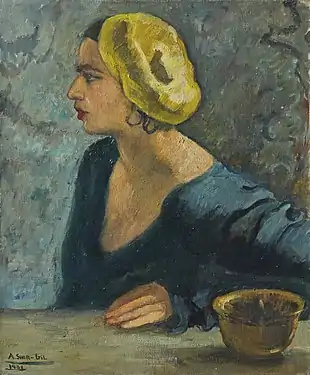 |
1931: Amrita Sher-Gil self portrait |
Private collection | 65.1 × 54 cm Oil on canvas |
Completed in Paris. In 2015 it was sold for £1.7 million at auction in London.[26][lower-alpha 2] |
| 1931: Alfred Cortot |
New Delhi, National Gallery of Modern Art | 44 × 30 cm Pastel on paper |
Depicts Alfred Cortot[27] | |
| 1931: Portrait of a Young Woman |
New Delhi, National Gallery of Modern Art | 32 × 42.5 cm Oil on canvas[28] |
||
| 1931: Victor Egan |
Egan refers to this portrait as "a stupid picture of me".[29] | |||
| 1931: Violins |
New Delhi, National Gallery of Modern Art | 59 × 82 cm Oil on canvas[28] |
One of six paintings submitted to the "end of year concours" in summer 1932.[6] | |
| 1931: Woman in Blue Coat |
Private[19] | 48 × 66 cm Oil on canvas[19] |
||
| 1931: Girl in Mauve |
New Delhi, National Gallery of Modern Art | 36 × 53.7 cm Oil on canvas[19] |
Painted in Paris.[19] | |
Paintings (1932)
| Painting | Year Name |
City, Gallery | Dimensions Technique |
Notes |
|---|---|---|---|---|
| 1932: Adam and Eve |
New Delhi, National Gallery of Modern Art | 38.7 × 52.1 cm Oil on canvas[30] |
||
| 1932: Still Life with Green Bottles and Apples |
Private collection[28] | 37 × 54.5 cm Oil on canvas[28] |
Painted in Paris.[28] | |
| 1932: Nude Self-Portrait with Palette |
Whereabouts unknown[6] | Possibly "my nude" that Sher-Gil submitted to the "end of year concours" in summer 1932.[6] | ||
| 1932: Self-Portrait with a Smile |
Private collection[1] | 45 × 32 cm Oil on canvas |
[31] | |
| 1932: Self-Portrait in Green |
Private collection[19] | 64.8 × 90 cm Oil on canvas[19] |
Completed in Paris around June 1932, and described by Sher-Gil as "a very good self-portrait".[4] | |
| 1932: Department Store |
New Delhi, National Gallery of Modern Art | 49.5 × 62 cm Oil on canvas[30] |
Likely the store called Printemps that she took a sketch of in June 1932.[32] | |
| 1932: The Blue Danube |
Unknown[18] | Painted in Hungary.[30] | ||
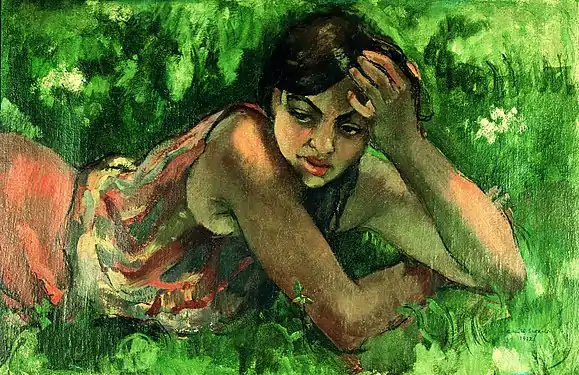 |
1932: Hungarian Gypsy Girl |
New Delhi, National Gallery of Modern Art | 81.3 × 52.7 cm Oil on canvas[30] |
One of two paintings of the same girl who posed for Sher-Gil in old clothes, completed in the summer of 1932 in Zebegény.[6] |
| 1932: Gypsy Girl from Zebegény |
Private collection[23] | 41 × 62 cm Oil on canvas[23] |
One of two paintings of the same girl who posed for Sher-Gil in old clothes, completed in the summer of 1932 in Zebegény.[6] | |
| 1932: Two Children on a Hillside |
On 2 August 1932, after completing the Gypsy Girls, Sher-Gil began a large painting of two poor girls in Zebegény.[6]
Sher-Gil wrote to her parents in the summer of 1934 requesting they sell "the two little girls I painted in Zebegény, which I hate".[33] In January 1937, she mentions selling the "picture of the two children on a hillside I had painted in Zebegény".[34] It is possibly the "small rotten painting" she describes as sold at the Hyderabad exhibition for ₹250 in December 1936.[34] | |||
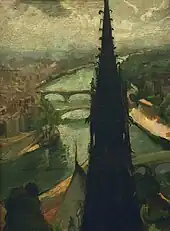 |
1932: Notre Dame |
59.5 × 81 cm Oil on canvas[30] |
This was being created in June 1932, in Paris.[6] | |
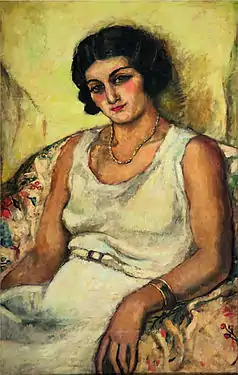 |
1932: Klarra Szepessy |
53.5 × 99.5 cm Oil on canvas[23] |
Portrait of Sher-Gil's mother's younger sister.[35] | |
| 1932: Portrait of Denise Prouteaux |
[36] | |||
| 1932: My Grandmother |
New Delhi, National Gallery of Modern Art | 46 × 63.5 cm Oil on canvas |
Portrait of Antonia Grottesmann née Martonfalvy (1864-1937), painted in Hungary.[29] | |
| 1932: Young Man with Apples |
New Delhi, National Gallery of Modern Art | 71 × 97 cm Oil on canvas[23] |
One of three portraits Sher-Gil completed of Boris Taslitzky,[24] this was exhibited at the XII Salon des Tuileries in 1934.[37][38]
Number 25 of 33 of Sher-Gil's works displayed at her solo exhibition at Faletti's Hotel in Lahore, British India, held from 21 to 27 November 1937.[10] There, it was priced at ₹500.[10] | |
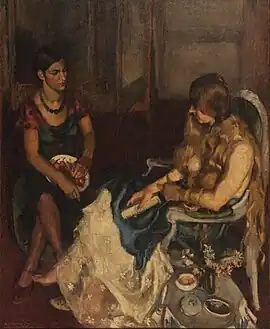 |
1932: Young Girls |
New Delhi, National Gallery of Modern Art | 133 × 164 cm Oil on canvas[30] |
Painted in June 1932.[8]
One of six paintings submitted to the "end of year concours" in summer 1932.[6] Earned Sher-Gil the appointment of associate member of the 1933 Paris Salon.[2] |
| 1932: Marie-Louise Chassanay |
New Delhi, National Gallery of Modern Art | 66.5 × 94.5 cm Oil on canvas[23] |
[39] | |
| 1932: Male Torso |
||||
| 1932: Sitting Nude |
[6] | |||
| 1932: Viola Egan |
Private collection[23] | Painted in Hungary[23] | ||
| 1932: Girls in Conversation |
Private[30] | 82 × 53 cm Oil on canvas[23] |
||
Paintings (1933)
| Painting | Year Name |
City, Gallery | Dimensions Technique |
Notes |
|---|---|---|---|---|
| 1933: Open Air Painters |
New Delhi, National Gallery of Modern Art | 53 × 84 cm Oil on canvas[40] |
||
| 1933: The Girl in Black |
Unknown[40] | Painted in Paris[40]
This was cut of a large unfinished painting depicting Sher-Gil, Indira, Denise Prouteaux, and a nude model, and gifted to Denise.[41] According to Prouteaux, it was taken by a German officer during the occupation of Paris.[41][42] | ||
| 1933: Spanish Girl |
59 × 91.5 cm Oil on canvas[40] |
|||
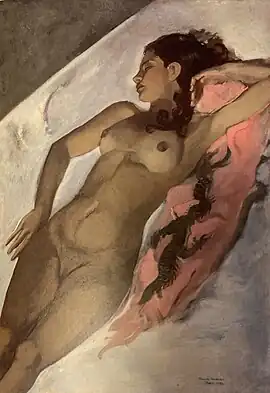 |
1933: Sleep |
New Delhi, National Gallery of Modern Art | 112.5 × 79.1 cm Oil on canvas[40] |
Painted in Paris 1932-1933, it depicts Sher-Gil's sister Indira.[6][43]
Displayed at the 1937 exhibition in Lahore for a price of ₹1,000, but did not sell.[10] It was later left with the Indian National Congressman and her friend Diwan Chaman Lall "to see if he could palm it off on someone but he wasn't successful".[44] |
| 1933: Reclining Nude |
New Delhi, National Gallery of Modern Art | 70.7 × 93.5 cm Oil on canvas[40] |
Completed in Budapest, it depicts Sher-Gil's cousin Viola, sister of her husband Victor Egan.[42][45] | |
| 1933: Professional Model |
New Delhi, National Gallery of Modern Art | 72× 100 cm Oil on canvas[40] |
Created in 1933 in Paris and depicts a nude consumptive. Its vernissage took place in February 1933.[46]
Displayed at the 1937 exhibition in Lahore.[10] | |
Paintings (1934)
| Painting | Year Name |
City, Gallery | Dimensions Technique |
Notes |
|---|---|---|---|---|
| 1934: Model in Green |
Created in 1934 in Paris and modelled on the same nude as in Professional Model.[47] | |||
| 1934: Self-portrait with long hair |
Private collection[40] | 35.5× 45.7 cm Oil on canvas[40] |
Painted in Paris[40] | |
| 1934: Model in Brown |
Created in 1934 in Paris and modelled on the same nude as in Professional Model.[47] | |||
| 1934: View from Studio |
Private collection[40] | 42 × 45.6 cm Oil on canvas[40] |
In 1938, at the All India Fine Arts and Crafts Society's exhibition in Delhi, it was awarded best picture in oils and gold medal for best picture by a female artist.[13] In Sher-Gil's opinion it was the "weakest" of the five paintings she submitted.[13] | |
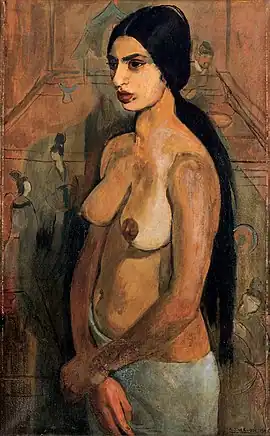 |
1934: Self-Portrait as a Tahitian |
Delhi, Kiran Nadar Museum of Art | 90 × 56 cm Oil on canvas |
[48] |
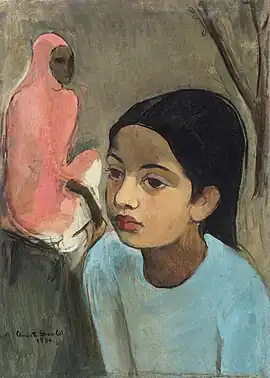 |
1934: The Little Girl in Blue |
India, private collection | 48 × 40.6 cm Oil on canvas[49] |
One of Sher-Gil's earliest paintings upon returning to India in 1934.[50]
Displayed at the 1937 exhibition in Lahore, with a sale price of ₹150, and bought by Charles Fabri.[10] Sold by auction in 2018 for ₹18.69 crore, equivalent to $2.67 million.[21][51] |
| 1934: View from Majitha House |
Payal and Rajiv Chaudhri, New York[52] | 33× 23 cm Oil on canvas[52] |
Painted in December 1934[49] |
Paintings (1935)
| Painting | Year Name |
City, Gallery | Dimensions Technique |
Notes |
|---|---|---|---|---|
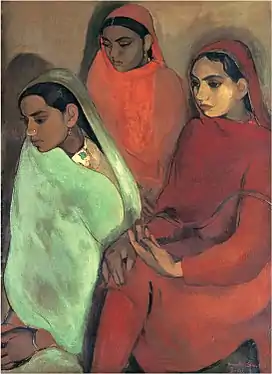 |
1935: Three Girls |
New Delhi, National Gallery of Modern Art | 92.8 × 66.5 cm Oil on canvas[52] |
Completed on 1 January 1935.[8]
Sher-Gil wrote to her mother on 1 January 1935 "Today I finished the painting of Mahindra's three daughters. It is excellent".[53] Also called Group of Young Girls, it was displayed at the 1937 exhibition in Lahore for a price of ₹700.[10][54] |
| 1935: Portrait of Malcolm Muggeridge |
Sikander Rahim, Pakistan[49] | Painted at Simla.[49] | ||
| 1935: Malcolm Muggeridge |
New Delhi, National Gallery of Modern Art[49] | 59.5 × 94 cm Oil on canvas |
Painted at Simla.[49] | |
| 1935: Beggars |
Private[49] | 59 × 84 cm Oil on canvas[49] |
||
| 1935: Woman with Fan |
New Delhi, National Gallery of Modern Art | 59 × 82.5 cm Oil on canvas[52] |
Painted in July 1935 at Mashobra, Simla, modelled on Prakash, Umrao Singh's daughter by his first marriage.[55]
Sher-Gil possibly later made alterations to the face.[17] | |
| 1935: Hill Women |
89 × 147.3 cm Oil on canvas[49] |
Painted in November 1935 at Simla.[49]
Exhibited at the Paris Salon in 1936 and then at Hyderabad for a price of ₹2,500, where it was admired by Sarojini Naidu, who tried to persuade the Museum of Hyderabad to acquire the painting.[34] Displayed at the 1937 exhibition in Lahore for a price of ₹1,500.[10] | ||
| 1935: Hill Men |
89× 148.5 cm Oil on canvas[49] |
Painted in December 1935.[49] | ||
| 1935: Woman on Terrace |
Private collection[52] | 73.6 × 99 cm Oil on canvas[52] |
Painted in February 1935 at Majitha House, Amritsar, and modelled on Mohindra's maid Guro.[56]
Displayed at the 1937 exhibition in Lahore for a price of ₹500.[10] | |
| 1935: Boys with Lemons |
Private collection[52] | 56 × 90 cm Oil on canvas[52] |
Painted at Simla.[52] | |
| 1935: Mother India |
New Delhi, National Gallery of Modern Art | 62 × 78 cm Oil on canvas |
Painted in May/June 1935 at Simla.[8][57] Displayed at the 1937 exhibition in Lahore for a price of ₹500.[10] | |
| 1935: Portrait of Father |
60 × 91.5 cm Oil on canvas |
Painted in May/June 1935 at Simla.[8][57]
Displayed at the 1937 exhibition in Lahore for a price of ₹500.[10] | ||
| 1935: Man in White |
Painted at Simla and modelled on Prem Chand (1911-1995).[57]
Displayed at the 1937 exhibition in Lahore for a price of ₹350.[10] | |||
| 1935: Nude Group |
New Delhi, National Gallery of Modern Art | 81.3 × 114.3 cm Oil on canvas[52] |
In the foreground is Sumair Kaur.[58] | |
| 1935: Two Women |
New Delhi, National Gallery of Modern Art | 74 × 100 cm Oil on canvas[52] |
Painted at Saraya.[52] | |
Paintings (1936)
| Painting | Year Name |
City, Gallery | Dimensions Technique |
Notes |
|---|---|---|---|---|
| 1936: Raja Surat Singh |
Private[59] | 48.5 × 74 cm Oil on canvas[59] |
Painted in February 1936 at Saraya.[59] | |
| 1936: Portrait of Girl with Flower |
Private[59] | 30 × 40 cm Oil on canvas[59] |
Painted in March 1936 at Saraya.[59] | |
| 1936: The Little Untouchable |
Unknown[59] | Painted in March 1936 at Saraya.[59] | ||
| 1936: Child Wife |
Private[59] | 53 × 76 cm Oil on canvas[59] |
Painted in March 1936 at Saraya.[59] | |
| 1936: Sunder Singh |
Private[59] | 50.8 × 64.7 cm Oil on canvas[59] |
Painted in March 1936 at Saraya[59] | |
| 1936: Portrait of Joji |
Private[59] | 64.7 × 92.7 cm Oil on canvas[59] |
Painted in March 1936 at Saraya[59]
Depicts Joji, Jagjeevan/Gurjeevan (1913-2005), daughter of Kirpal Singh Majitha.[60] Sher-Gil wrote to her mother on 10 February 1936 that "I shall grudgingly paint her to her advantage so that she likes her image, and maybe she will purchase my painting".[60] | |
| 1936: Portrait of Sister |
Private[59] | 62 × 92.7 cm Oil on canvas[59] |
Painted at Simla.[59] | |
| 1936: Sumair |
New Delhi, National Gallery of Modern Art | 54 × 89 cm Oil on canvas[61] |
Portrait of Sumair Kaur, daughter of Umrao Singh's first son, Balram.[58][lower-alpha 3] | |
| 1936: Woman in Red |
Seeta Badrinath, Chennai[59] | 53 × 89 cm Oil on canvas[59] |
Painted at Simla.[59] | |
| 1936: Composition |
Private[59] | 68.5 × 91.4 cm Oil on canvas[59] |
Depicts a water jar in front of a child and a coolie.[62]
Painted in Simla and sold in November 1936 at Sher-Gil's exhibition at the Taj Mahal Palace Hotel Mumbai for ₹1,000 to Anand Prabha Shankar Pattani, son of Prabhashankar Pattani.[62] It was one of five of her paintings exhibited at the All India Fine Arts and Crafts Society's exhibition in Delhi in 1938.[13] | |
Paintings (1937)
| Painting | Year Name |
City, Gallery | Dimensions Technique |
Notes |
|---|---|---|---|---|
| 1937: Girl with Pitcher |
Unknown[61] | 68 × 105.4 cm Oil on canvas[61] |
Completed in April 1937.[61] | |
| 1937: Village Girl |
New Delhi, National Gallery of Modern Art | 56 × 90 cm Oil on canvas[61] |
||
| 1937: Namaskar |
New Delhi, National Gallery of Modern Art | 38 × 48.7 cm Oil on canvas[61] |
Painted at Simla.[61] | |
| 1937: Dressing the Bride |
Private[61] | 70 × 95 cm Oil on canvas[61] |
Painted at Simla.[61] | |
| 1937: Self-Portrait |
Private[61] | 52 × 78 cm Oil on canvas[61] |
Painted at Simla.[61] | |
| 1937: Fruit Vendors |
73.6 × 105.5 cm Oil on canvas[61] |
Painted in January 1937 at Cape Comorin.[61]
Displayed at the 1937 exhibition in Lahore for a price of ₹250.[10] | ||
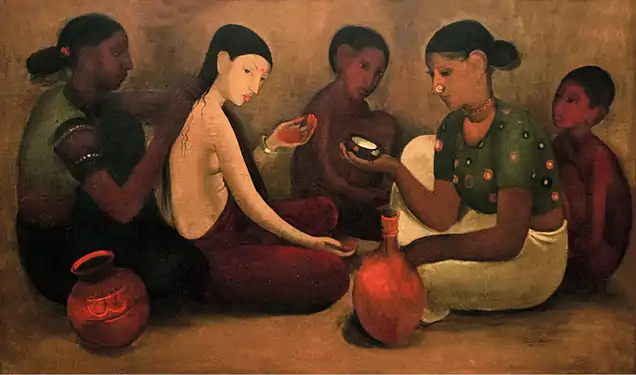 |
1937: Bride's Toilet |
New Delhi, National Gallery of Modern Art | 144.5 × 86 cm Oil on canvas[61] |
Completed in April 1937.[61]
One of Sher-Gil's South Indian trilogy.[63] Displayed at the Lahore exhibition (1937) for a price of ₹1,500.[10] |
| 1937: Villagers in Winter |
Oil on canvas |
One of Sher-Gil's South Indian trilogy.[63]
Displayed at the Lahore exhibition (1937) for a price of ₹1,500.[10] | ||
| 1937: Brahmacharis |
New Delhi, National Gallery of Modern Art | 144.5 × 86.5 cm Oil on canvas[64] |
Painted in May 1937 at Simla.[64]
One of Sher-Gil's South Indian trilogy.[63] Displayed at the Lahore exhibition (1937) for a price of ₹1,500.[10] | |
| 1937: Mendicant |
New Delhi, National Gallery of Modern Art | 36 × 52 cm Oil on canvas[64] |
Painted at Simla[64] | |
| 1937: Two Mendicants |
New Delhi, National Gallery of Modern Art | 66.5 × 89.5 cm Oil on canvas[64] |
Painted at Simla[64] | |
| 1937: My Grandmother Lady Jasbir Kaur |
||||
| 1937: Women on the Beach |
The Government and Art Gallery, Chandigarh[61] | 29.9 × 40 cm Oil on canvas[61] |
Painted at Cape Comorin.[61]
Modelled on South Indian women.[65] | |
| 1937: Self-Portrait |
Private collection | One of two self-portraits completed in Simla, Sher-Gil described this as "sugary".[66] | ||
| 1937: Self-Portrait in Blue Sari |
Private[61] | 45× 79 cm Oil on canvas[61] |
One of two self-portraits completed in Simla.[66] | |
| 1937: Raja o Kollengode |
Siddarth John, Thiruvananthapuram.[61] | 77.5× 116 cm Oil on canvas[61] |
Painted at Simla in March 1937.[61] | |
| 1937: Lady Daljit Singh of Kapurthala |
New Delhi, National Gallery of Modern Art[61] | 55× 89 cm Oil on canvas[61] |
Painted at Delhi[61] | |
| 1937: Head of a Girl |
Private[64] | 29 × 33 cm Oil on canvas[64] |
Painted at Simla.[64] | |
| 1937: Bullock Cart |
Private[64] | 41 × 30 cm Oil on canvas[64] |
Painted at Simla.[64] | |
| 1937: South Indian Villagers going to Market |
90 × 147.3 cm Oil on canvas[64] |
Painted at Sher-Gil's home, The Holme, Simla, around October 1937, along with the two smaller compositions The Story Teller and Siesta.[9][66]
Displayed at the 1937 exhibition in Lahore for a price of ₹1,500.[10] In 1940, the painting was one of six of Sher-Gil's works displayed at the Indian Academy of Fine Arts' Amritsar Exhibition (31 October - 10 November), to raise money for the War Fund.[15] | ||
| 1937: The Story Teller |
India, private collection | 59 × 79 cm Oil on canvas |
Bought by Badruddin Tyabji at the 1937 exhibition in Lahore, where it was put up for ₹250.[10]
Sold at auction in 2023 for ₹61.8 crore ($2.67 million).[67] | |
| 1937: Siesta |
New Delhi, National Gallery of Modern Art[64] | 83 × 55 cm Oil on canvas[64] |
Painted in October 1937 at Simla.[64]
According to Vivan Sundaram it was originally titled Fantasy, and completed at Simla.[66] Displayed at the 1937 exhibition in Lahore for a price of ₹750.[10] Sher-Gil in a letter to Khandelwal dated 19 December 1937, wrote "my fantasy (which I have called Painting)",[68] and was priced at ₹350 at Lahore.[10] Sher-Gil possibly later made alterations to the painting.[17] In 1940, the painting was one of six of Sher-Gil's works displayed at the Indian Academy of Fine Arts' Amritsar Exhibition (31 October - 10 November), to raise money for the War Fund.[15] | |
Paintings (1938)
| Painting | Year Name |
City, Gallery | Dimensions Technique |
Notes |
|---|---|---|---|---|
| 1938: Red Brick House |
Private[69] | 37 × 26.6 cm Oil on canvas[69] |
Completed in Lahore in January 1938.[69] | |
| 1938: Portrait of Helen |
Unknown[64] | 26.5 × 35 cm Oil on canvas[64] |
In January 1938 from Faletti's, Sher-Gil wrote to her parents "I have started on a head of Mrs. Chamanlal for which I don't wish to charge them anything".[70] | |
| 1938: Portrait of Shakuntala Kapur |
Unknown[64] | Commissioned portrait of Shakuntala Lall, who asked Sher-Gil to adjust her fingers to appear slender. Sher-Gil did as requested and left the painting unsigned.[71] | ||
.jpg.webp) |
1938: The Vina Player |
Lahore Museum, Lahore[64] | Displayed at the Lahore exhibition (1937), where it was bought for the museum.[10] | |
| 1938: Village Group |
Private[69] | 95 × 66 cm Oil on canvas[69] |
Painted in March 1938 at Saraya.[69] | |
| 1938: Women in Red |
New Delhi, National Gallery of Modern Art | 59.5 × 53.7 cm Oil on canvas[69] |
Painted in March 1938 at Saraya.[69] | |
| 1938: Elephants Bathing in a Green Pool |
81 × 56 cm Oil on canvas[69] |
Completed in Saraya in February 1938.[8]
It was one of five of her paintings exhibited at the All India Fine Arts and Crafts Society's exhibition in Delhi in 1938.[13] | ||
| 1938: Three Bullock Carts |
Private[69] | 78.7 × 40.6 cm Oil on canvas[69] |
Completed in Saraya in March 1938.[69] | |
| 1938: Hill Scene |
New Delhi, National Gallery of Modern Art | 65 × 87.5 cm Oil on canvas[69] |
Completed in Simla in April 1938.[69] | |
| 1938: Hill Side |
New Delhi, National Gallery of Modern Art | 65 × 87.5 cm Oil on canvas[69] |
Completed in Simla in June 1938.[69] | |
| 1938: Village Scene |
New Delhi, National Gallery of Modern Art | 84 × 62 cm Oil on canvas[69] |
Painted around February-March 1938,[8] in Simla.[69]
Sold in 2006 to an Indian businessman for $1.6 million.[8][72] | |
| 1938: In the Ladies Enclosure |
Private collection[69] | 81 × 56 cm Oil on canvas[69] |
Painted in March 1938 at Saraya.[69] | |
| 1938: Red Clay Elephant |
66 × 96.5 cm Oil on canvas[69] |
Completed in March 1938 at Saraya.[69]
Formerly known as Ganesh Puja.[57] | ||
| 1938: Red Verandah |
New Delhi, National Gallery of Modern Art | 71.6 × 144.2 cm Oil on canvas[69] |
Painted in May 1939 in Simla.[69] | |
| 1938: Sardarni Kirpal Singh Majitha |
Private collection[69] | 66 × 92.7 cm Oil on canvas[69] |
Painted in April 1938 in Saraya, Sher-Gil wrote to her mother in March 1938..."Kirpal has asked me to paint his wife from memory and the aid of a rotten photograph".[13][lower-alpha 4] | |
| 1938: Potato Peeler |
New Delhi, National Gallery of Modern Art | 59.5 × 72.7 cm Oil on canvas[73] |
Completed in November 1938[73] | |
| 1938: Hungarian Church Steeple |
Private[73] | 45.7 × 67.3 cm Oil on canvas[73] |
Painted in Kiskunhalas, Hungary, in November 1938, when she returned there to marry Viktor Egan.[14][73] | |
| 1938: Hungarian Market Scene |
New Delhi, National Gallery of Modern Art | 72 × 97 cm Oil on canvas[73] |
Painted in Kiskunhalas, Hungary, in November 1938, when she returned there to marry Viktor Egan.[14][73] | |
| 1938: Trees |
Zsuzsa Urbach, Budapest.[73] | 38.2 × 61 cm Oil on canvas[73] |
||
Paintings (1939)
| Painting | Year Name |
City, Gallery | Dimensions Technique |
Notes |
|---|---|---|---|---|
| 1939: Winter |
New Delhi, National Gallery of Modern Art | 73.6 × 52 cm Oil on canvas[73] |
Painted in Hungary in January 1939[73] | |
| 1939: Victor Egan |
Private collection of Manoj Israni (2022)[74] | 63.5× 80 cm Oil on canvas[73] |
Portrays Egan in army uniform, and sold in 2020 to Manoj Israni for ₹10.86 crore.[74] | |
| 1939: Female Torso |
New Delhi, National Gallery of Modern Art | 56 × 99 cm Oil on canvas[73] |
Painted in Budapest.[73] | |
| 1939: Two Girls |
Vivan & Navina Sundaram[73] | 89 × 129 cm Oil on canvas[73] |
Painted in Budapest in March 1939,[73] the dark girl is modelled on a dark Hungarian gypsy.[1][75][76] | |
| 1939: Merry Cemetery |
New Delhi, National Gallery of Modern Art | 73 × 98.5 cm Oil on canvas[73] |
Painted in Zebegény.[77] | |
| 1940: Resting |
New Delhi, National Gallery of Modern Art | 99 × 110.7 cm Oil on canvas[1] |
Painted in November 1939 at Simla.[1] | |
Paintings (1940)
| Painting | Year Name |
City, Gallery | Dimensions Technique |
Notes |
|---|---|---|---|---|
| Helen Chaman Lall | Portrait of Helen Chaman Lall | |||
| 1940: Ancient Story Teller |
New Delhi, National Gallery of Modern Art | 70 × 87 cm Oil on canvas[1] |
Painted at Saraya in 1940,[1] the painting was one of six of Sher-Gil's works displayed at the Indian Academy of Fine Arts' Amritsar Exhibition (31 October - 10 November), to raise money for the War Fund.[15] There, it was awarded the Sardar S. G. Thakur Singh Award (₹50) for best composition in oil.[15] | |
| 1940: The swing |
New Delhi, National Gallery of Modern Art | 70 × 91.4 cm Oil on canvas[1] |
Painted in February 1940,[1] the painting was one of six of Sher-Gil's works displayed at the Indian Academy of Fine Arts' Amritsar Exhibition (31 October - 10 November), to raise money for the War Fund.[15]
The main figure is modelled on (Tejwant Kaur (Teji), daughter of Kirpal Singh Majitha, Sher-Gil's cousin.[78] | |
| 1940: Woman on Charpoy |
New Delhi, National Gallery of Modern Art | 85 × 72.4 cm Oil on canvas[1] |
Completed at Saraya in June 1940.[54][57][79][80]
The main figure is modelled on Teji.[78] | |
| 1940: Bride |
New Delhi, National Gallery of Modern Art | 70 × 98 cm Oil on canvas[1] |
Painted at Saraya[8][81] | |
| 1940: Resting Mother |
New Delhi, National Gallery of Modern Art | 97 × 72 cm Oil on canvas[1] |
||
| 1940: Elephant Promenade |
New Delhi, National Gallery of Modern Art | 92.5 × 126.5 cm Oil on canvas[1] |
In 1940, the painting was one of six of Sher-Gil's works displayed at the Indian Academy of Fine Arts' Amritsar Exhibition (31 October - 10 November), to raise money for the War Fund.[15] | |
| 1940: Elephants |
New Delhi, National Gallery of Modern Art | 72 × 86.3 cm Oil on canvas[1] |
Painted in March 1940 in Saraya.[1]
In 1940, the painting was one of six of Sher-Gil's works displayed at the Indian Academy of Fine Arts' Amritsar Exhibition (31 October - 10 November), to raise money for the War Fund.[15] | |
| 1940: Two Elephants |
New Delhi, National Gallery of Modern Art | 43.2 × 52 cm Oil on canvas[1] |
Painted at Saraya.[1] | |
| 1940: Two Tigers and a small Elephant's Head |
Commissioned[82]
Sher-Gil wrote to Karl Khandalawal on 4 May 1940 that "the tigers were made to order. I don't consider it a work of art".[83] | |||
| 1940: Haldi Grinders |
New Delhi, National Gallery of Modern Art | 74.7 × 100 cm Oil on canvas[1] |
Painted at Saraya.[1] | |
| 1940: Hungarian Village Market |
Private[1] | 73 × 100 cm Oil on canvas[1] |
Painted at Saraya.[1] | |
| 1940: Musicians |
New Delhi, National Gallery of Modern Art | 67.5 × 93 cm Oil on canvas[1] |
Painted in December 1940.[1] | |
| 1940: Horse and Groom |
Unknown[1] | Painted at Saraya.[1] | ||
| 1940: Woman at Bath |
New Delhi, National Gallery of Modern Art | 70 × 92 cm Oil on canvas[1] |
Painted at Saraya.[1] | |
Paintings (1941)
| Painting | Year Name |
City, Gallery | Dimensions Technique |
Notes |
|---|---|---|---|---|
| 1941: Village Girls |
New Delhi, National Gallery of Modern Art | 44.3 × 52.2 cm Oil on canvas[1] |
Painted at Saraya in August 1941.[1]
From Sardarnagar, Gorakhpur, Sher-Gil wrote to Badruddin Tyabji on 3 September 1941 that she had completed the Village Girls after at least six months of not looking at her brushes. "The spell has suddenly broken now and I am working with passion.[84] In Sher-Gil's words it depicts "four little girls weaving baskets. The background an acid lemon, the children a medley of hot colour."[84] | |
| 1941: Camels |
New Delhi, National Gallery of Modern Art | 74.7 × 100 cm Oil on canvas[1] |
Painted at Saraya in September 1941.[1]
Sher-Gil wrote to her mother on 29 August 1941 that "I am doing a lot of drawings of animals. Camels, horses, baffles etc.".[85] In Sher-Gil's words it depicts "a curious rose coloured Indian saddle on one of the animals".[84] | |
| 1941: The Last Unfinished Painting |
New Delhi, National Gallery of Modern Art | 65.7× 87. cm Oil on canvas[1] |
Was being painted in September 1941 at Lahore.[8] | |
Notes
- ↑ In Self-Portrait as a Tahitian " her tanned naked body is slightly turned, a possible reference to the artist's longing to return to India".[7]
- ↑ Not mentioned in Sundaram's book
- ↑ Sumair (born 1918), became a model in Paris and was later associated with the underworld, Nazis and Axis agents. Bernard Wasserstein describes her as having "a podgy face and snub nose, and was somewhat short for a model".[58]
- ↑ Kirpal Singh (1891-1944) was Sher-Gil's cousin, married to Raminder Kaur (1894-1936), also known as Sardarni Kirpal Singh Majitha[8]
References
- 1 2 3 4 5 6 7 8 9 10 11 12 13 14 15 16 17 18 19 20 21 22 23 24 25 26 27 28 29 30 31 32 33 34 35 36 37 38 39 Sundaram, pp. 796-811
- 1 2 Dalmia, p. 31
- ↑ Sundaram, pp. 412-413
- 1 2 Sundaram, pp. 72-79
- 1 2 3 4 Sher-Gil, Amrita (2014). "1. Evolution of my art". In Dalmia, Yashodhara (ed.). Amrita Sher-Gil: Art & Life : a Reader. Oxford University Press. pp. 3–8. ISBN 978-0-19-809886-7.
- 1 2 3 4 5 6 7 8 9 10 11 12 Sundaram, pp. 80-85
- 1 2 3 Haupt, Christina (2016). Amrita Sher-Gil and the representations of non-western female bodies. Norderstedt: Grin. pp. 2–4. ISBN 978-3-6684-887-7-9.
- 1 2 3 4 5 6 7 8 9 10 11 Sundaram, pp. vi-xliii
- 1 2 3 Dalmia, pp. 98-100
- 1 2 3 4 5 6 7 8 9 10 11 12 13 14 15 16 17 18 19 20 21 Sundaram, pp. 422-424
- ↑ Sundaram, pp. 418-421
- ↑ Sundaram, pp. 430-431
- 1 2 3 4 5 6 Sundaram, pp. 471-473
- 1 2 3 Singh, N Iqbal (1975). "Amrita Sher-Gil". India International Centre Quarterly. 2 (3): 209–217. ISSN 0376-9771.
- 1 2 3 4 5 6 7 8 9 Sundaram, pp. 684-685
- ↑ The Protection of Movable Cultural Property: Compendium of Legislative Texts. Unesco. 1984. p. 167. ISBN 978-92-3-101638-7.
- 1 2 3 Dalmia, pp. 204-205
- 1 2 3 4 5 6 7 8 Sundaram, p. 798
- 1 2 3 4 5 6 7 8 Sundaram, p. 799
- ↑ Dalmia, p. 54
- 1 2 Shaw-Johnson, Amanda (2021). Why Now?: The Euro-U.S. Canon Adopts Tarsila do Amaral and Amrita Sher-Gil Almost 90 Years Later (Thesis). UC Davis.
- ↑ Sundaram, p. 78
- 1 2 3 4 5 6 7 8 9 10 11 Sundaram, p. 800
- 1 2 3 4 Sundaram, pp. 98-99
- ↑ Dalmia, pp. 34-35
- ↑ Roy, Amit (2015). "Sold: Sher-Gil self-portrait for £1.7m". www.telegraphindia.com. Archived from the original on 25 November 2023. Retrieved 25 November 2023.
- ↑ "Alfred Cortot". www.museumsofindia.gov.in. Archived from the original on 12 January 2024. Retrieved 8 January 2024.
- 1 2 3 4 5 Sundaram, p. 797
- 1 2 Sundaram, pp. 60-61
- 1 2 3 4 5 6 7 Sundaram, p. 801
- ↑ Sundaram, p. 102
- ↑ Sundaram, pp. 76-79
- ↑ Sundaram, pp. 140-141
- 1 2 3 Sundaram, pp. 278-285
- ↑ Sundaram, p. 56
- ↑ Jhala, Kabir (2 March 2021). "Rediscovered portrait by India's most famous female painter Amrita Sher-Gil expected to sell for $2.8m". The Art Newspaper - International art news and events. Archived from the original on 4 January 2024. Retrieved 23 December 2023.
- ↑ Dalmia, pp. 39-42
- ↑ Higgie, Jennifer (2021). The Mirror and the Palette: Rebellion, Revolution and Resilience: 500 Years of Women's Self-Portraits. Hachette. p. 190. ISBN 978-1-4746-1380-4.
- ↑ Anand, Mulk Raj (1989). Amrita Sher-Gil. National Gallery of Modern Art. p. 10.
- 1 2 3 4 5 6 7 8 9 10 11 12 Sundaram, p. 802
- 1 2 Sundaram, pp. 112-115
- 1 2 Sundaram, Vivan; Sher-Gil, Umrao Singh (2001). Re-take of Amrita: Digital Photomontages Based on Photographs by Umrao Singh Sher-Gil (1870-1954) and Photographs from the Sher-Gil Family Archive. Tulika. p. 55. ISBN 978-81-85229-49-2.
- ↑ Singh, Nikky-Guninder Kaur (2011). "8. Sikh art". Sikhism: An Introduction. New York: Bloomsbury Publishing. pp. 239–250. ISBN 978-1-84885-320-1.
- ↑ Sundaram, pp. 522-523
- ↑ Sundaram, p. 94
- ↑ Dalmia, p. 50
- 1 2 Dalmia, pp. 29-30
- ↑ Bhushan, Nalini (2020). "19. Amrita Sher-Gil: identity and integrity as a mixed-race woman artist in colonial India". In Alston, Charlotte; Carpenter, Amber; Wiseman, Rachael (eds.). Portraits of Integrity: 26 Case Studies from History, Literature and Philosophy. London: Bloomsbury Publishing. pp. 195–206. ISBN 978-1-350-04039-7.
- 1 2 3 4 5 6 7 8 9 10 11 12 Sundaram, p. 804
- ↑ Dalmia, pp. 59-75
- ↑ "Amrita Sher-Gil's 'The Little Girl in Blue' fetches Rs 18.69 crore". Tribune. 30 November 2018. Archived from the original on 12 November 2023. Retrieved 12 November 2023.
- 1 2 3 4 5 6 7 8 9 10 11 12 Sundaram, p. 803
- ↑ Sundaram, pp. 184-185
- 1 2 Mandakini; Gupta, Ila; Jha, P. (2016). "20. Gender and space in the paintings of Raja Ravi Varma and Amrita Sher-Gil". In Seta, Fumihiko; Biswas, Arindam; Khare, Ajay; Sen, Joy (eds.). Understanding Built Environment: Proceedings of the National Conference on Sustainable Built Environment 2015. Springer. pp. 237–254. ISBN 978-981-10-2136-7.
- ↑ Sundaram, pp. 208, 334
- ↑ Sundaram, pp. 192-196
- 1 2 3 4 5 Sundaram, pp. 642-647
- 1 2 3 Sundaram, pp. 178-181, 202
- 1 2 3 4 5 6 7 8 9 10 11 12 13 14 15 16 17 18 19 20 21 22 23 24 25 Sundaram, p. 805
- 1 2 Sundaram, p. 227-229
- 1 2 3 4 5 6 7 8 9 10 11 12 13 14 15 16 17 18 19 20 21 22 23 24 25 26 27 28 Sundaram, p. 806
- 1 2 Sundaram, pp. 260-261
- 1 2 3 Dalmia, pp. 201-202
- 1 2 3 4 5 6 7 8 9 10 11 12 13 14 15 16 17 18 19 20 Sundaram, p.807
- ↑ Dalmia, pp. 84, 90
- 1 2 3 4 Sundaram, pp. 416-417
- ↑ "Amrita Sher-gil's 'The Story teller' is now the most expensive Indian painting! Oil on canvas masterpiece fetches Rs 61.8 cr at Delhi auction". The Economic Times. 2023-09-19. ISSN 0013-0389. Archived from the original on 2023-09-26. Retrieved 2023-09-19.
- ↑ Sundaram, pp. 428-429
- 1 2 3 4 5 6 7 8 9 10 11 12 13 14 15 16 17 18 19 20 21 22 23 24 25 26 27 Sundaram, p. 808
- ↑ Sundaram, pp. 438-439
- ↑ Singh, N. Iqbal (1984). Amrita Sher-Gil: A Biography. Vikas. p. 118. ISBN 978-0-7069-2474-9.
- ↑ Sooke, Alastair (24 February 2007). "Laid bare - the free spirit of Indian art". The Telegraph. Archived from the original on 17 December 2023. Retrieved 17 December 2023.
- 1 2 3 4 5 6 7 8 9 10 11 12 13 14 15 16 17 18 Sundaram, p. 809
- 1 2 Gupta, Jahnavi (24 December 2020). "Amrita Sher-Gil's rare portrait fetches over Rs 10 crore". Hindustan Times. Archived from the original on 1 January 2024. Retrieved 12 December 2023.
- ↑ Sundaram, pp. 570-572
- ↑ Dalmia, pp. 118-19
- ↑ Dalmia, p. 198
- 1 2 Sundaram, pp.498-499
- ↑ Sen, Geeti (2002). Feminine fables : imaging the Indian woman in painting, photography,and cinema. Ahmedabad: Mapin Publishing. p. 63. ISBN 978-81-85822-88-4.
- ↑ Dalmia, pp. 135, 149-150
- ↑ Dalmia, p. 136
- ↑ Dalmia, pp. 138-139
- ↑ Sundaram, pp. 638-641
- 1 2 3 Sundaram, pp. 743-745
- ↑ Sundaram, pp. 737-741
Bibliography
- Dalmia, Yashodhara (2013). Amrita Sher-Gil: A Life. Gurugram: Penguin Books. ISBN 978-0-14-342026-2.
- Sundaram, Vivan (2010). Amrita Sher-Gil: A Self-Portrait in Letters and Writings. Vol. 1. New Delhi: Tulika Books. pp. 1–417. ISBN 978-81-89487-59-1.
- Sundaram, Vivan (2010). Amrita Sher-Gil: A Self-Portrait in Letters and Writings. Vol. 2. New Delhi: Tulika Books. pp. 418–821. ISBN 978-81-89487-59-1.
External links
- "Amrita Sher-Gil (list of paintings held at the National Gallery of Modern Art, Delhi)". ngmaindia.gov.in. Archived from the original on 11 November 2023. Retrieved 11 November 2023.
- "Classical Indian Art -Dec-14, 2015 -Lot 45 -". Saffronart. Retrieved 23 December 2023.